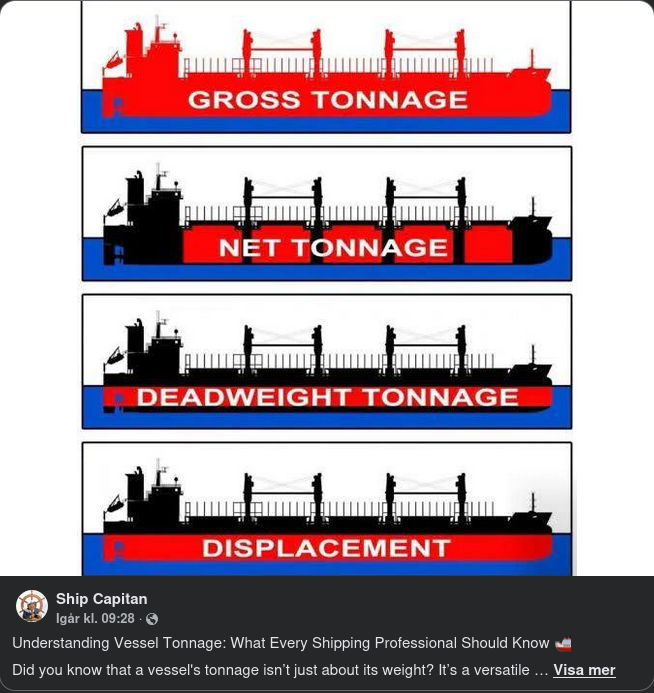Olika Sorters Fartygstonnage
2025-01-18


Did you know that a vessel's tonnage isn’t just about its weight? It’s a versatile term that defines size, capacity, and even revenue potential. Here’s a quick dive into the key types of tonnage and why they matter:
 Gross Register Tonnage (GRT): Measures the vessel’s total internal volume (think engine rooms, cargo holds, living spaces) and influences port fees, safety rules, and regulations.
Gross Register Tonnage (GRT): Measures the vessel’s total internal volume (think engine rooms, cargo holds, living spaces) and influences port fees, safety rules, and regulations. Net Register Tonnage (NRT): Focuses on cargo-carrying spaces, representing the vessel’s earning capacity.
Net Register Tonnage (NRT): Focuses on cargo-carrying spaces, representing the vessel’s earning capacity. Deadweight Tonnage (DWT): The total weight a vessel can safely carry, including cargo, fuel, and provisions. A critical metric for capacity planning.
Deadweight Tonnage (DWT): The total weight a vessel can safely carry, including cargo, fuel, and provisions. A critical metric for capacity planning. Displacement Tonnage: The total weight of the vessel and its contents—commonly used for naval vessels and stability analysis.
Displacement Tonnage: The total weight of the vessel and its contents—commonly used for naval vessels and stability analysis. Lightweight Tonnage (LWT): The vessel’s weight without fuel or cargo—important for ship valuation and scrapping.
Lightweight Tonnage (LWT): The vessel’s weight without fuel or cargo—important for ship valuation and scrapping. Cargo Tonnage: Represents the actual weight or volume of cargo carried.
Cargo Tonnage: Represents the actual weight or volume of cargo carried. Special Canal Tonnage: Used specifically to calculate transit fees for the Panama and Suez Canals.
Special Canal Tonnage: Used specifically to calculate transit fees for the Panama and Suez Canals.Why it matters:
Tonnage isn’t just a technical metric—it’s the foundation of operations, commercial decisions, and regulatory compliance in the shipping industry. From port fees to international safety conventions, tonnage affects it all.
#earndeckshipping #marinesurvey #sealife #education
Visa ditt stöd till det informationsarbete Carl genomför
Patreon
Swish

Scanna QR eller skicka till 076-118 25 68. Mottagare är Caroline Norberg.
